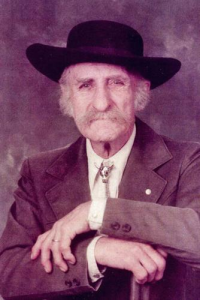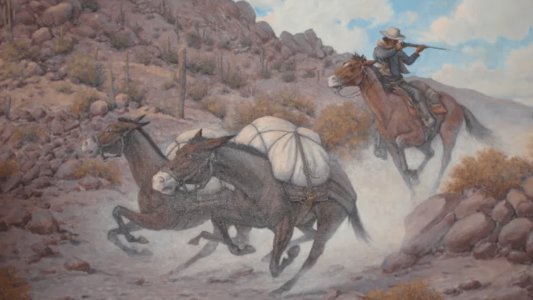
Biography
Clarence "Cal" Nicholas Peters was born in Port Washington, WI in 1903. At age 13 he was commissioned by a Chicago statuary company to create backgrounds for stations of the cross. After high school he studied at the Society of the Divine Word, a Roman Catholic missionary order in Techny, IL, and at the Art Institute of Chicago. He claimed to disdain academic art, feeling that it encouraged copying and preferred to base his painting on his intensive personal research. In this manner he became expert in such arcana as historical military uniforms and equipment.
After working as a freelance artist, Peters was employed by the Stout Institute in Menomonie, WI at in 1935, where he painted three large murals and completed a dozen portraits. He painted a mural of the airport in Madison, WI in 1936 and anther for the Naval Reserve Academy, also in Madison, in 1937.
A new museum opened in Prairie du Chien in 1938 and hired Peters to produce a number of murals and dioramas. He remained at Prairie du Chien for a decade, also making dioramas for Fort Mackinac, WI.
He moved to California in 1948 to work at the Natural History Museum of Los Angeles County. In 1956 he produced dioramas in San Mateo, CA. Other dioramas were created by him for the Death Valley Museum at Furnace Creek, the Riverside Metropolitan Museum and San Mateo.
In 1960 Peters began working in Arizona. His paintings and dioramas for the Postal History Foundation remain on display in Tucson. He created a mural and sculptures for the Tubac Presidio State Park and paintings and a diorama for the Tumacacori National Park.
Still at work on a painting of the Coarsegold Mining Camp in 1984, Peters was killed in an automobile crash in Acton, CA.

Critical Analysis
Cal Peters was meticulous in the research he did for his many paintings, murals and dioramas. He studied extensively the historical materials describing his proposed subjects, and he spent time in the wilds of Northern Wisconsin to familiarize himself with the landscape appropriate to his Menomonie murals. his craftsmanship was superb, and many of his dioramas remain on display in museums in Wisconsin, California and Arizona.
The verisimilitude of his work has, however, caused problems with his reputation. Many of his paintings depict the era of colonialist expansion in the United State and the concommitant clash with Native American civilizations. These works were typically presented from the white man's point of view, an outlook that sometimes clashes with modern sensibilities.
Unfortunately, as is often the case, criticisms of Peters's paintings have sometimes gone too far. While it might be legitimate to question the prominent display of a massacre of Native Americans, as is depicted in Peters's "Battle of Bad Axe," this sort of objection should not really extend to paintings that depict whites and Native Americans meeting in the natural environment where such encounters did take place. Confusion about Peters's work has led to on-again, off-again efforts to remove this paintings from public view. Fortunately, his murals have not typically been destroyed, although some have been relocated to less public venues.
Murals
- Menomonie, Wisconsin - University of Wisconsin - Stout, Harvey Hall: French Trappers on the Red Cedar
- Menomonie, Wisconsin - University of Wisconsin - Stout, Harvey Hall: Learning, Industry, Skill and Honor
- Menomonie, Wisconsin - University of Wisconsin - Stout, R.S. Swanson Library and Learning Center: Perrault's Trading Fort
References
- The Battle of Bad Axe (Wisconsin Historical Society).
- Clarence (Cal) Peters Murals (Menomonie, Wisconsin) (National Coalition Against Censorship).
- Robby Soave, Political Correctness: UW-Stout Censors 'Harmful' Native American Murals, Reason 8.8.2016 (2016).
- Uni. of Wisconsin-Stout Moves to Censor Paintings of First Nations People; Update: Chancellor Modified Course, Painting to be Relocated (National Coalition Against Censorship).
- Allison Meier, University Plans to Remove Two WPA Murals for Colonial Depictions, Hyperallergic August 12 (2016).